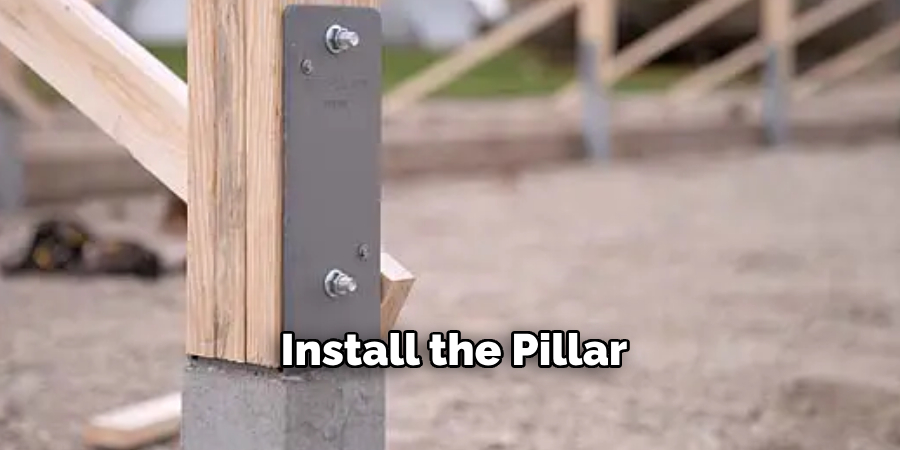Are you wondering how to make wooden pillars? Wooden pillars are a beautiful and timeless addition to any home or outdoor space.

Creating wooden pillars is an excellent way to add character, functionality, and structural support to various spaces. Whether you are renovating a home, building furniture, or crafting decorative elements, wooden pillars can be designed to suit your specific needs and aesthetic preferences.
This guide on making wooden pillars will walk you through the essential steps and tools required to craft wooden pillars successfully, ensuring a sturdy and polished result that can enhance any project. With some preparation and attention to detail, you can achieve professional-quality results while building something entirely your own. Let’s get started!
What Are the Benefits of Using Wooden Pillars?
There are several benefits to using wooden pillars in your construction or decorative projects. Some of these benefits include:
- Natural Aesthetic Appeal: Wooden pillars have a warm, organic look that adds character and charm to any space.
- Versatility: Wooden pillars can be designed and customized to fit into various architectural styles, from traditional to modern.
- Strength and Durability: Wooden pillars can support buildings or other structures when properly constructed.
- Cost-effective: Wood is generally more affordable than other materials like stone or metal, making it a budget-friendly option for those looking to incorporate pillars into their project.
- Easy to Work With: Wood is a relatively easy material to work with, making it a popular choice for DIY projects or for builders and designers looking to create custom pillars.
What Will You Need?
When working with wood to create pillars, there are a few essential tools and materials that you will need. These include:
- Wood of Your Choice: As mentioned earlier, wood is available in different types, such as hardwood, softwood, or engineered wood. Depending on your project’s needs and budget, you can choose the type of wood that best suits your requirements.
- Saw: A saw will be necessary to cut the wood to the desired size and shape.
- Drill: A drill will help you create holes in the wood for screws or nails to hold the pieces together.
- Sandpaper: After cutting and drilling, sandpaper can smooth out any rough edges or surfaces on the wood.
- Measuring Tools: Accuracy is key in woodworking, so having measuring tools such as a tape measure, level, and square will ensure precise cuts and angles.
- Clamps: Clamps are useful for holding pieces of wood together while the glue dries or while you drill or saw them.
- Wood Glue: For projects that require joining two or more pieces of wood together, wood glue is an essential tool. It creates a strong bond and is easy to use.
- Screws: Depending on your project, you may need screws or nails to hold the pieces of wood together. Make sure to choose the right size and type for your project.
10 Easy Steps on How to Make Wooden Pillars
Step 1: Gather Your Materials

Before starting your project, ensure you have all the necessary materials and tools to save time and avoid interruptions later. Assemble items such as wood planks or beams for the pillars, a measuring tape, a pencil for marking, a saw for cutting, wood glue for bonding, screws or nails, sandpaper for smoothing, a drill, clamps to secure the wood while working, and any desired finishes like paint, varnish, or wood stain. Having everything prepped and organized will make the process smoother and help you achieve a more professional and polished result.
Step 2: Plan Your Design
Start by sketching out your design on paper or using design software. Consider your project’s dimensions, style, and functionality, ensuring it fits the intended space and purpose. Determine the size and shape of each component and take precise measurements to guide your work. Think about the type of wood and finishes that best match your aesthetic goals and consider how the structure will be assembled. Careful planning at this stage will save time and minimize potential errors during construction.
Step 3: Cut the Wood
Using the measurements and plans you’ve created, carefully cut the wood to the required dimensions. Ensure you have the proper tools to achieve precise cuts, such as a saw, tape measure, and clamps. Double-check your measurements before cutting to avoid mistakes, as inaccuracies could affect the final assembly. Always prioritize safety by wearing protective gear, such as safety goggles and gloves, and working in a well-ventilated, stable area. Take your time to create clean, accurate cuts, as this will ensure your project comes together smoothly in later steps.
Step 4: Sand the Edges

Use sandpaper or a sanding block to smooth the edges of your cut pieces. Start with coarse-grit sandpaper to remove rough spots or splinters, then gradually move to finer grits for a polished finish. Pay special attention to corners and edges to ensure they are even and free of sharp or uneven areas. Properly sanded edges not only improve the aesthetic appeal of your project but also enhance safety by eliminating potential hazards. Be sure to wipe away any dust or debris with a clean cloth before proceeding to the next step.
Step 5: Assemble the Base
To assemble the base, lay out all the pre-cut pieces on a flat, stable surface according to the design plan. Ensure that all components are correctly aligned before securing them in place. Use wood glue along the edges to create a strong bond, and immediately follow up with screws or nails for additional stability. Using clamps to hold the pieces tightly together while the glue sets is helpful. Double-check that the base is level and square at every step to prevent any structural issues later. Allow the glue to fully cure before moving on to the next phase of your project.
Step 6: Reinforce with Screws or Nails
Using screws or nails is essential for adding lasting stability to your structure. Choose the appropriate size and type of screws or nails based on the thickness and type of wood you are working with. Begin by pre-drilling pilot holes to prevent the wood from splitting, especially near the edges. Space the screws or nails evenly along the joints to ensure a uniform and secure connection. Drive them in carefully, ensuring they are flush with the surface but not over-tightened. If possible, use a combination of screws and nails to provide both flexibility and strength, ensuring that your project can withstand pressure and maintain its integrity over time.
Step 7: Build the Pillar

To construct the pillar, assemble the prepared wooden pieces in the desired configuration. Secure the base firmly before stacking the subsequent sections to ensure stability. Use clamps to hold the pieces in place while fastening them with screws or nails. Check that the pillar remains vertical by using a level during assembly. Attach these components after the main structure is complete if the design includes decorative elements or additional support. Finally, sand down any rough edges and inspect the pillar for sturdiness before moving on to the next step.
Step 8: Sand the Entire Pillar
To achieve a smooth and refined finish, use sandpaper or a sanding block to sand the entire surface of the pillar thoroughly. Begin with a coarse grit to remove imperfections, rough edges, or excess material, and then gradually transition to finer grits to create a polished surface. Pay special attention to corners and edges, ensuring they are uniformly smooth. Remove any dust or debris using a damp cloth or vacuum once sanding is complete. Proper sanding not only enhances the appearance of the pillar but also prepares it for painting or staining in the following steps.
Step 9: Apply the Finish
Once the pillar is thoroughly sanded and cleaned, it’s time to apply the chosen finish. Select a high-quality paint, stain, or sealant based on your desired aesthetic and the pillar’s environment. If painting, use a primer first to ensure even coverage and better adhesion. Apply the finish evenly using a brush, roller, or sprayer, working in long, smooth strokes to avoid streaks or clumps. Allow the first coat to dry completely before applying additional coats, if needed, for optimal durability and appearance. Lightly sand the surface between coats with fine-grit sandpaper to ensure a smooth, professional finish. Proper application of the finish will protect the pillar from wear and environmental damage while enhancing its overall look.
Step 10: Install the Pillar
Once the finish has dried completely, carefully position the pillar in its designated location. Ensure it is appropriately aligned and level with the surrounding structure. Depending on the design, you may need to secure the pillar using brackets, screws, or adhesive. Double-check that all connections are tight and stable to guarantee the pillar is firmly in place. Inspect the installation thoroughly for any adjustments needed before concluding the process. Proper installation will ensure both aesthetic appeal and structural support.

By following these steps, you can confidently install a pillar in your home and enhance your space’s overall look and feel.
Conclusion
How to make wooden pillars is a rewarding process that combines craftsmanship and practicality.
Attention to detail is key at every stage, from selecting the right materials to carefully measuring, cutting, and assembling each component. By properly sanding, finishing, and securely installing the pillars, you can achieve a professional result that enhances your space’s aesthetics and functionality.
With patience and precision, wooden pillars can become a timeless and elegant addition to your home or project.

